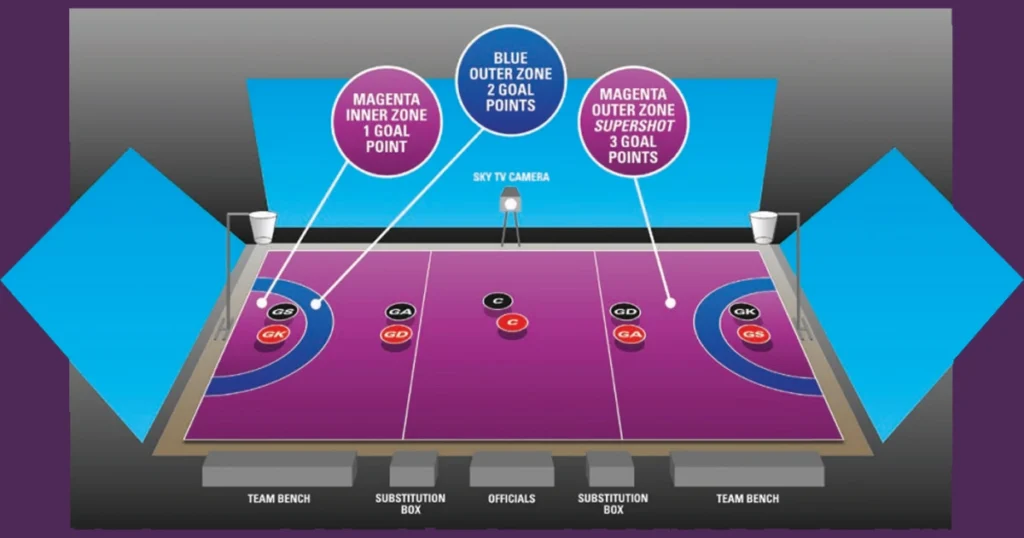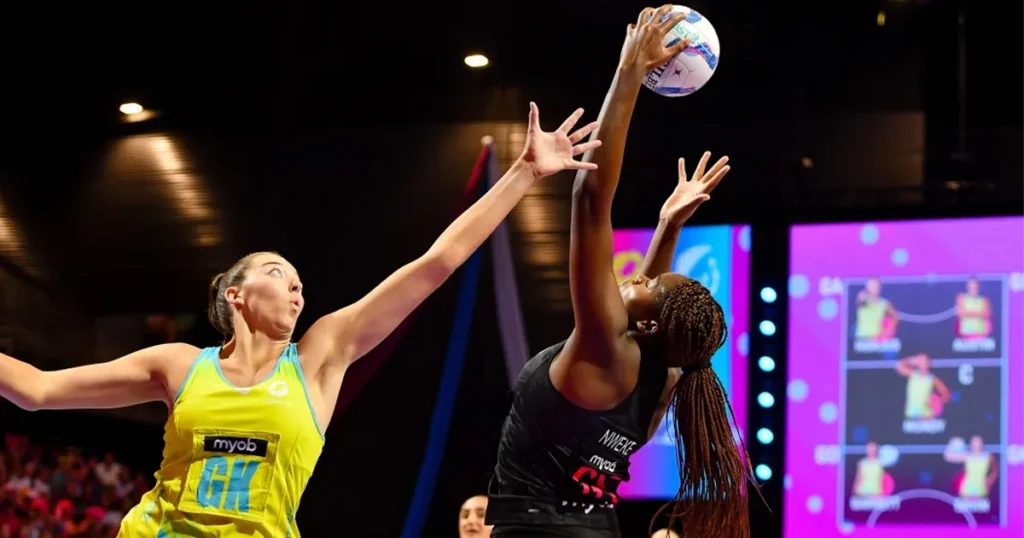FAST5 Netball Game Structure fast-paced and action-packed format, FAST5 Netball gives traditional netball a new look. This variation of the game acquaints a few interesting components planned with upgrade both player execution and observer commitment. Shorter quarters, a smaller court, and a unique Power Play scoring system are key features of FAST5 Netball Game Structure. These changes make the game faster and seriously invigorating, separating it from the customary netball design.
In this article, we will give an exhaustive outline of FAST5 Netball Game Structure, zeroing in on its down structure, court format, and rules. In addition, we’ll talk about training strategies and team strategies tailored to this high-energy format.
- Overview of FAST5 Netball’s unique features
- Court dimensions and equipment modifications
- Game rules, scoring system, and strategic elements
- Team composition, player roles, and gameplay strategies
- Training and preparation tips for FAST5 Netball
- Challenges and future prospects for the game
Ready to dive deeper into the world of FAST5 Netball Game Structure? Keep reading to uncover all the essential details and insights into this thrilling version of the sport.
Overview of FAST5 Netball
The FAST5 Netball Game Structure faster pace and streamlined rules of FAST5 Netball distinguish it from traditional netball. The game is intended to offer a really captivating encounter for the two players and observers by highlighting more limited quarters, less players, and an emphasis on fast interactivity.
The FAST5 Netball Game Structure advancement from conventional netball to FAST5 involved a few key changes. These alterations planned to hold the center components of netball while presenting components that make the game really exciting and available. FAST5 Netball Game Structure arrangement requests to current crowds by stressing pace and energy.
- Shorter Quarters: Definition and Key Characteristics Each of the four quarters in a game typically lasts between 6 and 8 minutes.
- Less Players: Each group has seven players, rather than the conventional group of seven players on each side.
- Special Rules: Incorporates alterations, for example, the Show of dominance and explicit scoring frameworks.
- Evolution from the Traditional Adaptations for Netball: Changes in court size, game term, and player jobs to improve the game’s speed.
- Expanded Commitment: Changes pointed toward supporting crowd interest and investment.
With its high-energy alternative to the standard game format, FAST5 Netball Game Structure stands out as a novel take on the sport.
FAST5 Netball Court and Equipment
The FAST5 Netball Game Structure court is outstandingly more modest than the conventional netball court. This plan is expected to oblige the game’s quicker speed and improve the power of matches, bringing about more unique and drawing in ongoing interaction.
FAST5 Netball uses equipment that is similar to Teams Competing in FAST5 Netball but has been slightly modified to accommodate the quicker format. These FAST5 Netball Game Structure adjustments guarantee that players will be able to perform well in the fast-paced game environment.
- Court Dimensions and Layout
- Court Size:The FAST5 court estimates 30.5 meters by 15.25 meters, contrasted with the conventional netball court’s 30.5 meters by 15.25 meters.
- Layout Changes: The goal circles are smaller, and there are fewer court markings to speed up play.
| Aspect | Traditional Netball Court | FAST5 Netball Court |
| Length | 30.5 meters | 30.5 meters |
| Width | 15.25 meters | 15.25 meters |
| Goal Circle Size | Larger | Smaller |
- Equipment Differences
- Ball: The same size as traditional netball but may have slight adjustments for better handling.
- Uniforms: No significant changes, but teams may opt for more aerodynamic gear.
The modified court and equipment contribute significantly to the unique FAST5 Netball Game Structure experience.
Game Rules and Structure
FAST5 Netball Game Structure is played in four shorter quarters of 6 to 8 minutes each. This structure ensures a rapid pace, maintaining the match’s high level of excitement.
The FAST5 Netball Game Structure Power Play is a new scoring option that gives teams the opportunity to double their points during a predetermined time period. Teams must carefully plan their Power Plays to have the greatest impact because this strategic element adds an additional layer of strategy to the game.
| Aspect | Details |
| Game Duration | Four quarters, 6-8 minutes each |
| Scoring System | Regular and Power Play points |
| Power Play | Doubles points for a specific period |
Game Duration and Quarters- Quarter Length: Each quarter is designed to be quick and intense, fitting within the 6-8 minute range.
- Breaks: Short breaks between quarters to allow teams to strategize and regroup.
- Scoring System and Power Play
- Regular Scoring: Points are awarded based on goals scored from within the goal circle.
- Power Play: Teams can choose one quarter to double their points for added strategic depth.
The unique game structure and scoring rules of FAST5 Netball Game Structure create a fast-paced and strategic environment.
Team Composition and Player Roles
Seven players make up each FAST5 Netball team. Each player has a specific role in the team’s overall strategy. The jobs are intended to augment the game’s speed and smoothness, expecting players to be flexible and versatile.
FAST5 Netball encourages players to play multiple roles on the court, in contrast to traditional netball, where roles are more fixed. Managing the game’s rapid pace and dynamic nature requires this flexibility.
- The size of the team is: Each group has seven players, instead of the customary configuration of seven players for every side.
- Rotation: In order to maintain high energy levels throughout the game, players may be rotated more frequently.
- Positions and Duties of the Player Attack and Defense: Players are supposed to add to both hostile and cautious play, adjusting to the game’s fast changes.
- Versatility: Players are required to switch between positions and responsibilities because roles are less rigid.
For effective FAST5 Netball strategies to be developed, it is essential to comprehend the team’s composition and player roles.
Gameplay and Strategies
Teams must use strategies that emphasize speed, agility, and quick decision-making due to the fast pace of FAST5 Netball. The need for quick changes between attack and defense is emphasized by the smaller court size and shorter quarters.
Compelling systems frequently include high-pressure protection and productive utilization of Shows of dominance. Groups should adjust their strategies to use the game’s quick rhythm and benefit from scoring open doors.
- Dynamic Gameplay with a Quick Pace Quick Transitions: Groups need to quickly move among assault and safeguard, taking full advantage of the reduced court size.
- Extreme Intensity: The more limited quarters and fast speed request elevated degrees of endurance and speed from players.
Key Procedures for Progress
- Protective Strain: Carrying out high-pressure guard to upset the rival’s play.
- Timing of Power Play: Decisively timing Strategic maneuvers to augment scoring potential.
Dominating interactivity elements and key methodologies is basic for progress in FAST5 Netball.
Training and Preparation
The goal of FAST5 Netball training should be to improve speed, agility, and the ability to make quick decisions. The game’s fast pace and specific rules necessitate that players modify their training routines.
Drills that mimic FAST5 game conditions and emphasize rapid transitions and high-intensity play are necessary for effective preparation. Integrating FAST5-explicit systems into instructional meetings will assist groups with performing better during matches.
- Tips for FAST5 Speed Drill Training: Include exercises that improve quick footwork and sprinting.
- Training for agility: Center around drills that upgrade horizontal development and response times.
- Adapting the Traditional Intensity of Netball Training: Training sessions should be intensified and accelerated to match FAST5 conditions.
- Practise the Strategy: Consistently practise FAST5-explicit procedures to guarantee status during matches.
Legitimate preparation and readiness are pivotal for succeeding in the high speed climate of FAST5 Netball.
Challenges and Adaptations
FAST5 Netball presents unique difficulties, including adapting to the game’s rapid pace and strategic depth. The intensity of shorter quarters and the strategic demands of Power Plays may be difficult to manage for teams.
Adjusting to FAST5 Netball includes changing preparation procedures and creating systems that line up with the game’s construction. Increasing performance and success may result from effectively addressing these obstacles.
- Common Challenges in FAST5
- Pace Management: Keeping up with the fast tempo and maintaining performance throughout shorter quarters.
- Strategic Depth: Developing effective strategies to handle the unique rules and Power Plays.
- Adapting to FAST5 Rules
- Training Adjustments: Modifying training approaches to address specific FAST5 challenges.
- Tactical Flexibility: Enhancing team adaptability to the game’s fast pace and dynamic play.
The key to success in FAST5 Netball is overcoming obstacles and adapting as necessary.
The Future of FAST5 Netball
FAST5 Netball is expanding its global reach and experiencing significant growth. Its imaginative organization and energizing ongoing interaction add to its rising fame among players and onlookers.
The fate of FAST5 Netball looks encouraging, with potential for additional turn of events and coordination into worldwide contests. The larger netball landscape will continue to be influenced by the sport as it develops.
Development and Worldwide Extension
- Expanding Fame: The game’s drawing in design draws in additional players and fans around the world.
- Integration into the World: Potential for consideration in significant worldwide competitions and associations.
Influence on Netball Development
- Sport Development: Traditional netball formats may be influenced by FAST5 Netball’s success.
- Future Patterns: The sport’s emerging trends may encourage further innovation and adaptation.
FAST5 Netball’s future will be determined by its ongoing expansion and development.
Conclusion
FAST5 Netball stands apart from customary netball through its quicker paced structure and inventive standards. The high-energy atmosphere of the game is aided by the game’s shorter quarters and smaller court dimensions, and the game’s unique Power Play system adds a strategic layer to scoring. To succeed in this format, teams must adjust to the fast tempo and varied player roles.
Due to the fast nature of the game, FAST5 Netball training emphasizes agility and quick decision-making. Difficulties, for example, dealing with the serious speed and key requests can be overwhelmed with designated planning and transformation of conventional netball preparing techniques. FAST5 Netball is an exciting alternative for those looking for a high-intensity version of the sport as it continues to expand globally.
FAQs
What are the most important distinctions between FAST5 Netball and standard netball?
The Power Play scoring system, shorter quarters, a smaller court, and fewer players are all features of FAST5 Netball. These progressions make the game quicker paced and more powerful.
In FAST5 Netball, how does the Power Play work?
The Show of dominance permits a group to twofold their focuses for objectives scored during a particular quarter. Groups should decisively pick whenever to utilize this chance to augment their score.
How much bigger is the FAST5 Netball court compared to the traditional court?
The FAST5 Netball court is 30.5 meters by 15.25 meters like the traditional court, but it has fewer markings and smaller goal circles to accommodate the faster pace.
How many FAST5 Netball players are there?
In contrast to the traditional team size of seven players on each side, each FAST5 Netball team has seven players.
What modifications to training are suggested for FAST5 Netball?
Speed, agility, and quick decision-making should all be the main goals of training. Players will have an easier time adjusting to the game’s faster pace if high-intensity drills and FAST5-specific strategies are incorporated.


